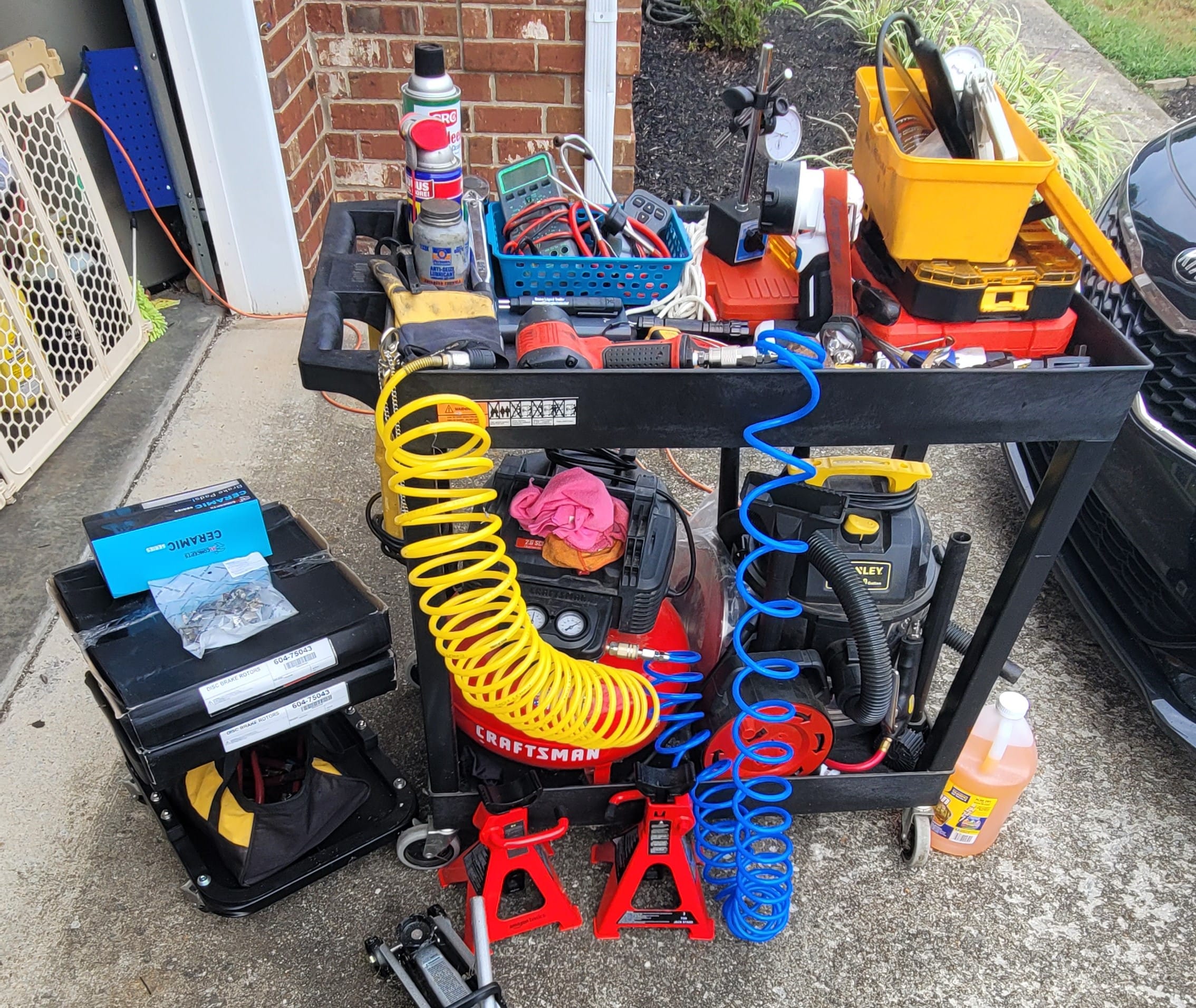Blog
2019 Lexus RX 350 Front Brakes

I did my daughter’s front brakes. Figured I would document my process in case it could help others.
Sorry for the audio and background noise, etc… in the video. This was a last minute decision to document the process so I didn’t bother setting up my fancy recording apparatus or practicing, just wanted to get er done. I figured someone may find it helpful. It’s pretty basic stuff but i do list torque specs and things like that and probably call things the wrong name LOL so… take it easy on me haha.
you will need:
brake and rotor ‘kit’ for the specific vehicle
safety glasses, ear plugs, gloves, etc…
cardboard, etc… to contain the mess under the work area, and for kneeling on, etc…
jack, jackstands, wheel chocks
torque wrench with 20~90 ft⋅lbf range
14mm (~25 ft⋅lbf), 19mm (~77 ft⋅lbf), and 21mm (~76 ft⋅lbf) sockets, wrenches, etc…
rags, brake cleaner, foam swabs, anti-seize compound, wire brush, etc…
method to compress dual piston systems if you can’t manually compress them
better with:
brake fluid moisture tester, pneumatic impact and ratchet, air blowing nozzle, low-profile mechanics stool with tool tray, extra brake fluid, fluid syphon pump (just in case), etc…
Here is an AI generated summary of the video:
The Ultimate Guide to Replacing and Reconditioning Brakes on a 2019 Lexus RX 350
Brakes are one of the most important parts of your vehicle. They keep you safe on the road by stopping your car when you need them. Over time, brakes wear out, and replacing or fixing them becomes necessary. Doing your own brake work might seem hard at first, but with the right steps and tools, you can do it confidently. This guide takes you through each step to inspect, disassemble, clean, and reassemble the brake system on a 2019 Lexus RX 350.
Understanding the Brake System of a 2019 Lexus RX 350
Overview of Brake Components
Every brake system has key parts that work together for safe stopping. The calipers squeeze the brake pads against the rotors to slow down the wheel. The brake pads press against the rotors to create friction. The rotors are metal discs attached to the wheels. Brake pins help the calipers slide smoothly. Sensors alert you when pads are worn out, and hydraulic fluid transfers force from the brake pedal to the calipers. Each piece plays a vital role in braking performance.
Unique Aspects of Lexus RX 350 Brakes
Lexus RX 350 uses specialized features like ABS sensors and wear indicators. The caliper pins are designed for smooth movement with correct lubrication. OEM specs recommend brake service intervals to keep braking sharp. Knowing these details helps you understand what to expect and how to maintain your brakes properly.
Preparing for Brake Service
Tools and Equipment Needed
Gather these tools before starting:
- Hydraulic jack and jack stands
- Impact wrench and socket set (preferably 21mm for lug nuts)
- Torque wrench to tighten bolts properly
- Screwdrivers, brushes, and clean rags
- Non-chlorinated brake cleaner
- Plastic tools and pick sets
- High-temp brake grease and antiseize compound
- Gloves, safety glasses, and a respirator if needed
Safety Precautions and Best Practices
Always work on a flat, stable surface. Use wheel chocks on the opposite tires and engage the parking brake. Support the vehicle with sturdy jack stands—never rely solely on the jack. Wear safety gear to protect your eyes and hands, especially when handling brake chemicals. Working safely keeps accidents at bay and ensures your tools work effectively.
Step-by-Step Brake Inspection and Fluid Testing
Checking Brake Fluid for Moisture Content
Start by inspecting the brake fluid reservoir. Use a moisture tester to see if the fluid has absorbed water. If the moisture level is high, it’s time to drain and replace the fluid. Also, check the filter basket inside the reservoir. Carefully remove it with a hooked tool, clean, and inspect it. Visually assess the fluid and decide if a flush is needed. Fresh brake fluid helps maintain optimal braking and prevents damage.
Assessing Brake Pad and Rotor Condition
Look for uneven pad wear or deep grooves on the rotors. Small cracks or scoring may indicate the need for rotor replacement. Measure the thickness of the pads—if they’re close to the minimum thickness, swap them out. Also, inspect caliper seals and pistons for leaks or rust. Catching these issues early keeps your brakes working smoothly.
Disassembling the Brake System
Lifting and Securing the Vehicle
Begin by parking your car on a flat surface. Chalk the back wheels to prevent movement. Use a hydraulic jack at the proper lift points on the Lexus RX 350—these are marked under the vehicle. Place jack stands under sturdy frame points and lower the car onto them. Always double-check stability before crawling underneath.
Removing the Wheels
Loosen lug nuts with an impact wrench. Keep them in a safe place and remove the wheels. Set them aside where they won’t get damaged. Now your brake system is exposed and ready for the next steps.
Detaching the Calipers and Rotors
Remove the two caliper pins (usually 14mm). Once those are out, carefully lift or support the caliper with a bungee cord or wire—never let it hang on the brake hose. Remove the brake pads from the caliper. Next, unbolt the rotor from the hub, taking care not to damage the wheel hub surface. Wiggling and gentle tapping may be needed for stuck rotors.
Disassembling Calipers and Pads
Take pictures or videos during disassembly to remember the order of parts. Carefully remove slide pins and clips, cleaning them as you go. Examine the pistons and seals for damage. Clean the caliper parts thoroughly to prepare them for reconditioning or replacement.
Cleaning and Reconditioning Brake Components
Brake Part Cleaning and Airborne Particles Safety
Spray non-chlorinated brake cleaner inside the calipers, and on rotors and pins. Use a spray and a rag to wipe away dirt and brake dust. Protect your eyes and lungs by wearing safety glasses and gloves. Spraying at an angle minimizes dust becoming airborne. Always work in a ventilated space.
Inspections and Damage Checks
Inspect each part carefully. Look for scratches, corrosion, or uneven wear. Replace any worn or damaged parts, such as seals or pistons. Rotors with dents or excessive rust should be replaced. Proper inspection prevents future brake failure.
Lubricating Moving Parts and Pins
Apply a high-temperature brake grease or antiseize compound on caliper pins and slide surfaces. Use precision tools or swabs to avoid excess grease spreading to other places. Proper lubrication ensures smooth caliper movement and even pad wear.
Preparing and Installing New or Reconditioned Components
Installing New Brake Pads and Wear Indicators
Position new pads making sure the wear sensors are correctly placed—usually on the inner pad’s top. Connect the sensor to the wiring harness, if applicable. Insert the pads into their slots, making sure they slide freely. Use the manufacturer’s torque specs to tighten pad clips and retainers.
Rebuilding Calipers
Replace worn bushings and seals if necessary. Carefully install pistons back into the caliper, lubricating them to prevent sticking. Make sure everything is seated properly and move smoothly before reassembling.
Installing the Rotor and Hardware
Clean the new rotor’s surface with brake cleaner. Attach it to the hub with mounting bolts—tighten to the specified torque, often around 77 ft-lb. Install hardware clips and springs as recommended by Lexus. Double-check all parts before proceeding to reassembly.
Reassembling the Brake System and Final Checks
Mounting Calipers and Securing Pins
Set the caliper back on the rotor. Insert and tighten the 14mm pins to 25 ft-lb torque. Ensure each pin is properly lubed and moves smoothly. Confirm that the pads are properly aligned and centered.
Reinstalling Wheels and Torque Settings
Put the wheels back on and tighten lug nuts by hand. Lower the vehicle slightly and use a torque wrench to tighten the lug nuts in an alternating pattern. For the Lexus RX 350, torque to 76 ft-lb. Fully lower the vehicle and tighten the last time.
Brake Bedding and Testing
Before driving normally, perform a brake bed-in procedure. Accelerate to about 30 mph and gently press the brake a few times to heat up the pads and rotors. Repeat at increasing speeds. This process ensures proper pad seating and optimal braking performance.
Maintenance Tips and Best Practices
- Test brake fluid every few months. Change it every 2-3 years or as needed.
- Watch for signs of brake trouble like squeaks, pulls, or soft pedal responses.
- Keep hardware clean and well-lubricated for longer lifespan.
- Park on level ground and avoid aggressive braking during initial use after service.
- When unsure, consult a qualified mechanic.
Conclusion
Replacing or reconditioning your Lexus RX 350 brakes isn’t as intimidating as it looks. The key is to take your time, keep parts organized, and follow proper safety procedures. Regular inspection and maintenance will keep your brakes sharp and responsive, making your drive safer. Remember, quality work and attention to detail can add years of reliable braking. Don’t forget—your safety depends on your brakes working perfectly. Take care of them, and they’ll take care of you.








